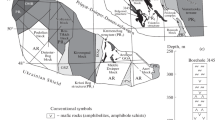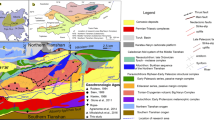Summary
In the eastern Vardar Zone of Greece, Na-dominant salic rocks are intimately associated with ophiolites, constituting a NW-trending, about 8 km thick belt along the western margin of the Serbomacedonian Massif. Though of different ages and metamorphic histories, both contrasted lithologic units display similar lateral variations. The salic rocks vary from a hypabyssal tonalite-trondhjemite series in the NW into granophyres and submarine volcanics in the SE. The juxtaposed ophiolites change in the same direction from tectonite peridotites overlain or intruded by mafic-ultramafic cumulates into sheeted dykes and submarine volcanics. The salic rocks were formed by multi-staged fractional melting of a mafic source and correspond chemically to the low-K andensite rhyolite series. The geological and chemical evidence points at an immature island-are setting for the salic rocks above a NE-dipping subduction zone. The lateral variations in their mode of occurrences probably reflect progressive attenuation of the continental crust. The corresponding variations displayed by the juxtaposed ophiolites may have resulted from a change in the plate motion from conservative in the NW to constructive in the SE.
Zusammenfassung
In der östlichen Vardar-Zone von Griechenland bilden Na-betonte salische Gesteine und Ophiolithe einen NW-streichenden, ca. 8 km mächtigen Gürtel entlang des westlichen Randes des Serbomazedonischen Massivs. Trotz verschiedenen Alters und unterschiedlicher metamorpher Beanspruchung zeigen die beiden lithologischen Einheiten gleiche laterale Variationen. Die salischen Gesteine wechsein von Tonaliten und Trondhjemiten im NW zu Granophyren und submarinen Vulkaniten im SE. Die tektonisch angrezenden, etwas jügeren Ophiolithe variieren in der gleichen Richtung von Tektonit-Peridotiten und den überlagrenden oder intrudierenden mafisch-ultramafischen Kumulaten zu einem Gangstockwerk und submarinen, vorwiegend basischen Vulkaniten. Die salischen Gesteine sind durch ein mehrphasiges fraktioniertes Aufschmelzen mafischen Materials entstanden und entsprechen chemisch der K-armen Reihe von basischem Andesit bis Rhyolith. Als Bildungsort weisen die geologischen und chemischen Kriterien auf einen inmaturen Inselbogen oberhalb einer nach NE gerichteten Subduktionszone während des Mittleren Juras hin. Veränderungen in den Ausbildungsformen der salischen Gesteine gehen offensichtlich auf ein progressives Verdünnen der kontinentalen Kruste zurück. Entsprechende Veränderungen in den gegenübergestellten Ophiolithen lassen sich durch Veränderungen in der Plattenbewegung von konservativ im NW zu konstruktiv im SE erklären.
Similar content being viewed by others
References
Arth JG, Hanson GN (1972) Quartz diorites derived by partial melting of eclogite or amphibolite at mantle depths. Contr Min Petrol 37: 161–174
—, Barker F (1976) Rare-earth partitioning between hornblende and dacitic liquid and implications for the genesis of trondhjemitic-tonalitic magmas. Geology 4: 534–536.
Barker F (1979) Trondhjemite: Definition, environment and hypothesis of origin. In: Barker F (ed) Trondhjemites, dacites, and related rocks, pp 1–12
—, Arth JG (1976) Generation of trondhjemitic-tonalitic liquids and Archean bimodal trondhjemite-basalt suites. Geology 4: 596–600
—, Peterman ZE, Friedman I (1976) The 1.7- to 1.8-b.y. old trondhjemites of southwestern Colorado and northem New Mexico: Geochemistry and depth of genesis. Geol Soc Am Bull 87: 189–198
Bischoff J, Dickson FW (1975) Seawater-basalt interaction at 200°C and 500 bars: Implications as to the origin of sea floor heavy metal deposits and regulation of seawater chemistry. Earth Planet Sci Lett 25: 385–395
Coleman RG (1977) Ophiolites. Springer, Berlin Heidelberg New York, p 229
Coleman RG, Donato MM (1979) Oceanic plagiogranite revisited. In: Barker F (ed) Trondhjemites, dacites, and related rocks, pp 149–168
Collerson KD, Fryer BJ (1978) The role of fluids in the formation and subsequent development of early continental crust. Contr Min Petrol 67: 151–167
Green TH, Ringwood AE (1968) Genesis of the calc-alkaline igneous rocks suites. Contr Min Petrol 18: 105–162
Hanson GN, Goldich SS (1972) Early Precambrian rocks in the Sagana Lake — Northern Light Lake area, Minnesota-Ontaric, Part 2: Petrogenesis. In: Doe BR, Smith DK (eds) Studies in mineralogy and Precambrian geology, Geol Soc Am Mem 135: 179–192
Hietanen A (1943) Über das Grundgebirge des Kalantigebietes im südwestlichen Finnland. Finlande Comm Geol Bull 130: p 105
— (1975) Generation of potassium-poor magmas in the northern Sierra Nevada and the Svecofennian of Finnland. J Research, US Geol Surv 3: 631–645
Hotz PE (1971) Plutonic rocks of the Klamath Mountains, California and Oregon. US Geol Surv Prof Paper 684-B, p 20
Irvine TN, Baragar WRA (1971) A guide to the chemical classification of the common volcanic rocks. Can J Earth Sci 8: 523–548
Jung D, Mussallam K, Burgath K, Kockel F, Mohr M, Raschka H (1981) Ultramafic and related rocks of Chalkidiki. Proc. Int Symp Metal Maf Ultramaf Complexes (Athens) 3: 24–42
Jung D, Mussallam K, (1985) The Sithonia Ophiolite: A fossil oceanic crust. Ofioliti, in press
Kockel F, Mollat H, Walther HW (1971) Geologie des Serbomazedonischen Massivs und seines mesozoischen Rahmens (Nordgriechenland). Geol Jb 89: 529–551
Kockel F, Mollat H (1977) Erläuterungen zur geologischen Karte der Chalkidiki und angrenzender Gebiete 1:100.000 (Nordgriechenland). Bundesanstalt für Geowissenschaften und Rohstoffe (Hannover), p 119
Koopmann C (1982) Mikroskopische und mineralchemische Untersuchung der SiO2-reichen Differentiate des Chalkidiki-Ophiolith-Komplexes (Nordost-Griechenland). Unpubl Dipl Arbeit, Hamburg, p 128
Kuno H (1968) Differentiation of basaltic magmas. In: Hess HH, Poldervaart A (eds) Basalts: The Poldervaart treatise on rocks of basaltic composition, pp 623–688
Makris J (1977) Geophysical investigations of the Hellenides. Hamburger Geophys Einzelschriften 34, Wittenborn Söhne, Hamburg. p 124
McGregor VR (1979) Archean gray gneisses and the origin of the continental crust: Evidence from the Godthab region, west Greenland. In: Barker F (ed) Trondhjemites, dacites and related rocks, pp 169–204
Mercier JL (1973) Etude géologique des zones internes des Hellénides en Macédoine centrale (Grèce). (Irethèse). Contribution à l'étude de l'évolution magmatique et du métamorphisme des zones internes des Hellénes (2e thèse). Ann Géol Pays Hell 20: p 792
Miyashiro A (1975) Classification, characteristics, and origin of ophiolites. J Geol 83: 249–281
—, Shido F (1975) Tholeiitic and calc-alkalic series in relation to the behaviors of titanium, vanadium, chromium and nickel. Am J Sci 275: 265–277
Mussallam K, Jung D (1985) Continental-type ophiolites and the early-stage of sea-floor spreading. Terra cognita 5: 77
Mussallam K, Jung D (1986) Geologie und Bau des Sithonia-Ophioliths: Anmerkungen zur Bildung ozeanischer Kruste. Geol Rdsch, in press
O'Conner JT (1965) A classification for quartz-rich igneous rocks based on feldspar ratios. US Geol Surv Prof Pap 525-B: 79–84
Payne JG, Strong DF (1979) Origin of the Twillingate trondhjemite, North-Central New-foundland: Partial melting in the roots of an island arc. In: Barker F (ed) Trondhjemites, dacites, and related rocks, pp 489–516
Pearce JA, Alabaster T, Shelton AW, Searle MP (1981) The Oman ophiolite as a cretaceous arc-basin complex: evidence and implications. Phil Trans R Soc A300: 299–317
Pearce JA, Lippard SJ, Roberts S (1984) Characteristics and tectonic significance of supra-subduction zone ophiolites. In: Geol Soc Lond Sp Publ, in press
Pearce JA, (1984) A “users guide” to basalt discrimination diagrams. In: Tarney J (ed) Oceanic basalts, in press
Peccerillo A, Taylor SR (1976) Geochemistry of Eocene calc-alkaline volcanic rocks from the Kastamonu area, Northern Turkey. Contr Min Petrol 58: 63–81
Phelps D (1979) Petrology, geochemistry and origin of the Sparta quartz diorite-trondhjemite complex, northeastern Oregon. In: Barker F (ed) Trondhjemites, dacites, and related rocks, pp 547–579
Phillips AH, Hess HH (1936) Metamorphic differentiation at contacts between serpentinite and siliceous country rocks. Am Min 21: 333–362
Rost F (1966) Über ultrabasische Einschlüsse in metamorphen Gesteinen des südlichen Moldanubikums. Krystalinikum 4: 127–162
Schünemann M (1985) Contributions to the geology, geochemistry and tectonics of the Chortiatis series metamorphic calc-alkaline suite, Chalkidiki, northern Greece, Diss Hamburg, p 181
Smith AG, Spray JG (1984) A half-ridge transform model for the Hellenic-Dinaric ophiolites. In: Dixon J, Robertson A, HF (eds) The geological evolution of the eastern Mediterranean, pp 629–644
Streckeisen A (1976) To each plutonic rock its proper name. Earth Sci Rev 12: 1–33
Upadhyay HD, Neale ERW (1979) On the tectonic regimes of ophiolite genesis. Earth Planet Sci Lett 43: 93–102
Winchester JA, Floyd PA (1977) Geochemical discrimination of different magma series and their differentiation products using immobile elements. Chem Geol 20: 325–343
Wyllie PJ (1979) Petrogenesis and the physics of the earth. In: Yoder HS (ed) The evolution of the igneous rocks, pp 483–520
Author information
Authors and Affiliations
Additional information
With 12 Figures
Rights and permissions
About this article
Cite this article
Mussallam, K., Jung, D. Petrology and geotectonic significance of salic rocks preceding ophiolites in the Eastern Vardar Zone, Greece. TMPM Tschermaks Petr. Mitt. 35, 217–242 (1986). https://doi.org/10.1007/BF01191987
Received:
Accepted:
Issue Date:
DOI: https://doi.org/10.1007/BF01191987




